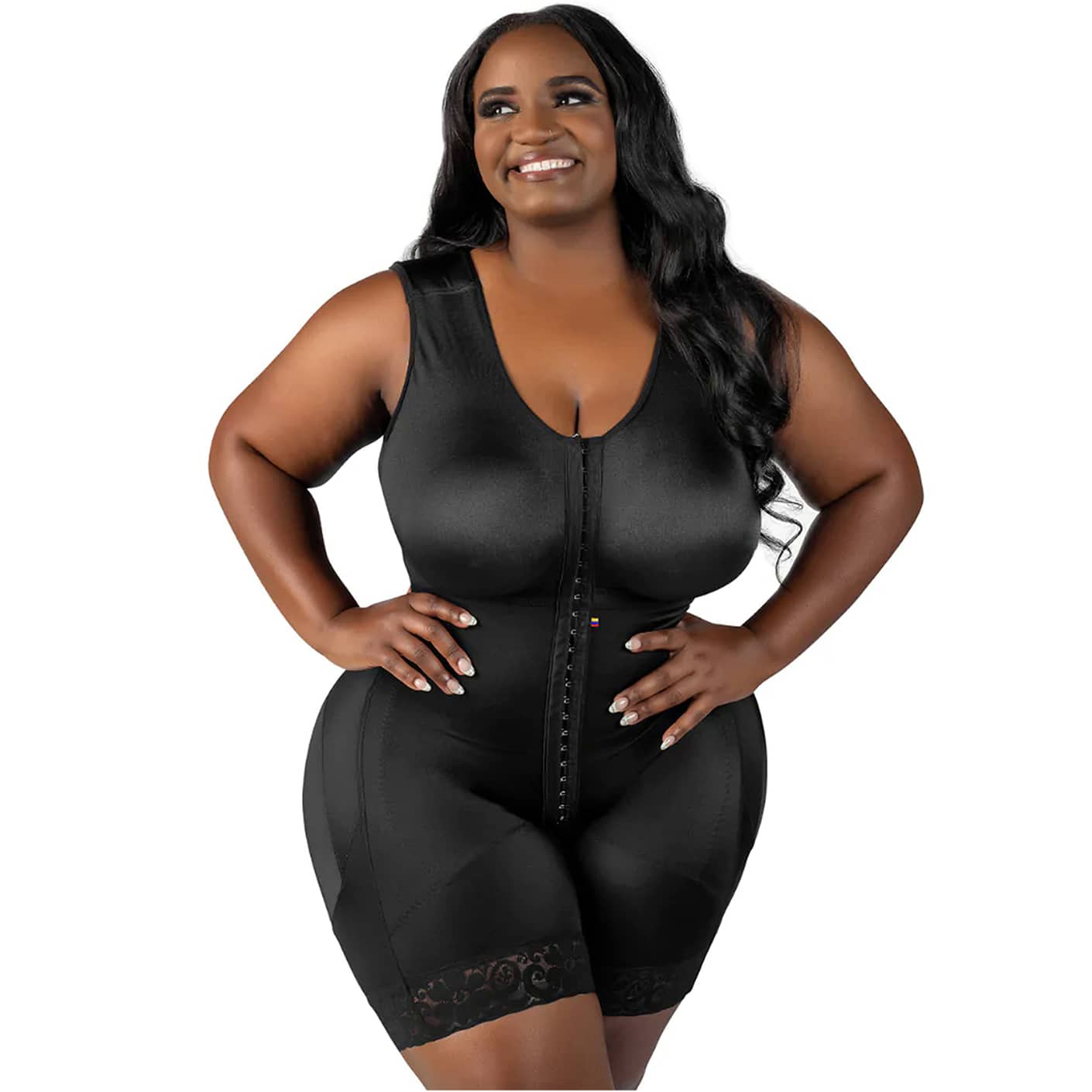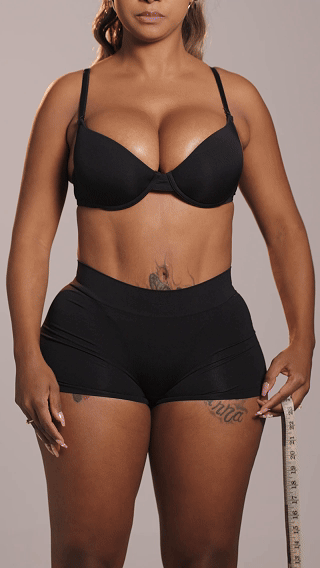The evolution of fajas in shapewear technology is not a secret. Fajas have emerged as a versatile solution, offering individuals the ability to enhance their natural curves, provide support, and aid in healing after surgery. Snatched Body has redefined the role of fajas, bringing innovation, quality, and style to the forefront. From post-surgical recovery to fitness excellence, our fajas are crafted to meet the diverse needs of women on their body shaping journey. However, the journey into the world of fajas can be overwhelming, from choosing the right size to understanding the daily benefits of wearing them and utilizing them effectively during post-surgical recovery. In this comprehensive guide, we delve deeper into each aspect to help you make informed decisions.
How to Choose the Right Size Faja:
If you want to know how to choose the right size faja, you need to consider to balance both comfort and effectiveness. Here's a closer look at the steps to ensure you find the perfect fit:
Precision in Measurements:
Begin by taking accurate measurements of your waist, hips, and bust. Manufacturers typically provide sizing charts, and it's crucial to match your measurements with the recommended size. Remember, different brands may have variations in sizing, so consider this when making your selection.
Mind the Compression Levels:
Fajas come with different compression levels, ranging from light to high. The compression level you choose depends on your body shaping goals and personal comfort preferences. Striking a balance between adequate compression and comfort is key to a positive experience.
Trial and Error Approach:
The fit can vary between brands, and your body's unique shape may require experimentation with different sizes to find the ideal match. Also remember to check the Return Policy.
Embrace Adjustable Features:
Look for fajas with adjustable elements such as hooks, zippers, or straps. These features allow you to customize the fit to your body's unique contours, ensuring optimal comfort and support.
Benefits of Wearing Fajas Daily:
Beyond the pursuit of a desired figure, wearing a faja daily offers a myriad of benefits for both physical and mental well-being. Let's explore the advantages that make these garments a staple in women´s routines:
Posture Enhancement:
Fajas provide essential support to the back and core muscles, contributing to improved posture. This added support can alleviate back pain and result in an overall more confident and upright appearance.
Instant Body Contouring:
One of the immediate benefits of fajas is their ability to shape and contour the body instantly. This can be particularly advantageous for special occasions or when you want a butt lift to enhance your natural curves and create a smoother silhouette.
Increased Sweat and Potential Fat Burning:
Some fajas are designed to elevate body temperature, promoting increased perspiration and potentially aiding in fat burning. However, it's important to approach this aspect with caution, understanding that fajas should complement a healthy lifestyle that includes proper diet and exercise.
Emotional Well-being:
Maybe you have heard about the psychological benefits of wearing fajas, it can boost confidence and self-esteem by providing a streamlined appearance. It is not just the impact of fajas on body image, it is also the emotional well-being that can positively impact various aspects of life, from professional settings to personal relationships.
Fajas for Post-Surgical Recovery Tips:
For those undergoing post-surgical recovery, fajas can play a pivotal role in facilitating a smooth healing process. For example, to achieve an excellent BBL recovery, using a BBL shapewear is crucial. Similarly, using a lipo 360 faja after a 360 liposuction is essential. Here are some essential tips to optimize the use of fajas during this critical period:
Consultation with Your Surgeon:
Before incorporating a Colombian faja into your post-surgical recovery routine, consult with your surgeon. They can provide valuable insights into the specific requirements of your procedure, recommend appropriate compression levels, and advise on when it's suitable to begin using a faja.
Gradual Introduction:
Ease into wearing the faja by starting with short periods and gradually increasing the duration as your body adjusts. This gradual approach minimizes discomfort and allows for proper healing without compromising the effectiveness of the compression.
Hygiene and Care:
Pay close attention to the cleanliness and care of your faja, adhering to the manufacturer's instructions. Maintaining proper hygiene is crucial, especially during the post-surgical recovery period, to minimize the risk of infections and promote overall well-being.
Regular Check-ins with Your Healthcare Provider:
Throughout your post-surgical recovery journey, schedule regular check-ins with your healthcare provider. They can monitor your progress, address any concerns, and ensure that the use of the faja aligns with your healing trajectory.
Navigating the world of Colombian fajas involves careful consideration at every step, from choosing the right size to understanding the daily benefits and optimizing their use during post-surgical recovery. By prioritizing precision in measurements, embracing the various benefits of daily wear, and following expert tips for post-surgical recovery, you can make the most of these versatile garments in enhancing both your physical appearance and overall well-being.
How to Care for and Wash Your Fajas:
Proper care and maintenance play a significant role in extending the lifespan of your fajas and preserving their functionality. Here's a step-by-step guide on how to care for and wash your fajas:
Check Our Instructions:
Begin by thoroughly reading and understanding the care instructions provided by us. Different materials and designs may have specific requirements, and adhering to these guidelines is crucial for maintaining the integrity of the garment.
Hand Wash Preferred:
While some fajas may be labeled as machine washable, it's generally recommended to hand wash them to prevent damage. Fill a basin with lukewarm water and add a mild detergent. Gently agitate the water to create suds.
Gentle Cleaning:
Submerge the faja in the soapy water and gently rub the fabric with your hands. Pay extra attention to areas with stains or odors. Avoid vigorous rubbing or wringing, as this can distort the shape and compromise the elasticity of the garment.
Rinse Thoroughly:
Once cleaned, rinse the faja under cold running water until all soap residue is removed. Ensure that you rinse both the inside and outside of the garment.
Pat Dry:
Avoid wringing out the faja, as this can damage the fabric and alter its shape. Instead, gently press the excess water out by patting the garment with a clean, dry towel.
Air Dry:
Lay the faja flat on a clean, dry towel to air dry. Avoid hanging it directly on a hanger, as this can cause stretching. Allow the garment to dry completely before wearing or storing.
Storage Considerations:
Store your fajas in a cool, dry place, away from direct sunlight. Folding them neatly can help maintain their shape, and placing tissue paper between layers can prevent colors from bleeding onto each other.
Comparing Different Types of Fajas Materials:
Fajas come in various materials, each with its unique properties and benefits. Understanding the differences can help you choose the right material based on your preferences and needs:
Powernet:
Powernet is a specialized fabric. Composed of a blend of nylon and elastane, it is known for its exceptional elasticity, durability, and shaping properties. Powernet provides varying levels of compression, is breathable, and offers flexibility without compromising durability. Its seamless design and post-surgical applications make it the best choice for those seeking comfortable and effective shaping solutions.
Latex:
Latex fajas are known for their high compression and shaping capabilities. They provide excellent support and are often used for waist training. However, some individuals may be allergic to latex, so it's essential to check for any adverse reactions.
Neoprene:
Neoprene fajas are popular for their thermal properties, promoting increased perspiration and potential fat burning. They are often chosen by those seeking enhanced workout performance or post-surgical recovery support.
Cotton:
Cotton fajas are breathable and comfortable, making them suitable for everyday wear. They are less restrictive than latex or neoprene options, making them a preferred choice for extended use.
Microfiber:
Microfiber fajas offer a smooth and lightweight feel. They are known for their seamless design, making them virtually invisible under clothing. Microfiber is an excellent option for those looking for comfort and discretion.
Lycra/Spandex:
Fajas made from Lycra or spandex provide excellent stretch and flexibility. They conform to the body's movements, making them suitable for various activities, including exercise and daily wear.
Understanding the characteristics of each material allows you to select a faja that aligns with your comfort preferences, lifestyle, and specific goals.
How Long Should You Wear a Faja Each Day:
Determining the ideal duration for wearing your faja depends on various factors, including your comfort level, the purpose of wearing the faja, and any specific recommendations from healthcare professionals or garment manufacturers. Here are some general guidelines:
Gradual Introduction:
If you are new to wearing a faja, start with shorter durations and gradually increase the time as your body adjusts. This approach allows you to gauge your comfort level and ensures a smooth transition into daily wear.
Post-Surgical Recovery:
As we said previously, follow the recommendations provided by your healthcare provider or surgeon. They may advise wearing the faja for a specific number of hours each day to support healing and enhance results.
Everyday Wear:
If you are wearing a faja for body shaping or posture improvement, consider wearing it for a few hours each day. This allows you to enjoy the benefits of enhanced support and contouring without causing unnecessary strain on your body.
Exercise Sessions:
Some women choose to wear a faja during exercise for additional support and increased perspiration. If using a faja for workouts, ensure that it is made from breathable and moisture-wicking materials. Additionally, listen to your body and remove the faja if you experience discomfort during physical activity.
Comfort as a Priority:
Regardless of the purpose, prioritize your comfort. If you feel any discomfort, pinching, or difficulty breathing, remove the faja and assess the fit. It's essential to strike a balance between reaping the benefits and maintaining your overall well-being.
Caring for and washing your fajas, understanding the differences in materials, and establishing a healthy daily wear routine are crucial aspects of maximizing the effectiveness and longevity of these garments. By following proper care practices, choosing the right material for your needs, and listening to your body when determining wear duration, you can make the most of your faja experience, whether for body shaping, post-surgical recovery, or everyday support.
The Role of Fajas in Medical Recovery Processes:
Fajas have become integral components in medical recovery, providing crucial support and aiding in the healing process after various surgical procedures. Here's a closer look at their roles:
Post-Surgical Support:
Fajas are often recommended by healthcare professionals post-surgery. They provide gentle compression to the treated area, reducing swelling and promoting proper circulation. This compression aids in the prevention of fluid buildup, expedites the healing process, and supports the body as it adjusts to changes.
Enhancing Blood Circulation:
The compression offered by fajas helps improve blood circulation in the targeted areas. This enhanced blood flow is beneficial for reducing inflammation and promoting the delivery of nutrients and oxygen to the tissues, aiding in a faster recovery.
Minimizing Discomfort:
Fajas can alleviate post-surgical discomfort by providing support to the surgical site. This support reduces movement and strain on the affected area, helping to manage pain and ensure a more comfortable recovery.
Contouring and Scar Management:
In addition to providing support, some fajas are designed to contour the body, assisting in scar management. The gentle pressure on the skin can contribute to minimizing the appearance of scars and promoting a smoother healing process.
Fajas and Fitness: Can They Improve Workout Results?
The intersection of fajas and fitness has sparked curiosity, with many women exploring the potential benefits of wearing these garments during workouts. Here's a look at how fajas may impact fitness results:
Increased Perspiration:
Some fitness enthusiasts opt for neoprene or thermal fajas with the goal of increasing perspiration during workouts. While this may lead to temporary water weight loss, it's crucial to recognize that any weight loss is likely due to fluid loss and not fat reduction. Staying hydrated is essential to avoid dehydration.
Support and Posture Enhancement:
Fajas can provide additional support to the core and back muscles during workouts, aiding in posture improvement. This support may contribute to a more stable and aligned body position, potentially enhancing exercise effectiveness and reducing the risk of injury.
Improved Circulation:
The compression provided by certain fajas may enhance blood circulation during physical activity. Improved circulation can support muscle oxygenation and nutrient delivery, potentially contributing to better endurance and recovery.
Contouring and Confidence:
Some women choose to wear fajas during workouts for their contouring effect. While this doesn't directly impact physical performance, the enhanced body shape may boost confidence and motivation, leading to a more positive exercise experience.
How to Avoid Common Mistakes When Buying Fajas:
Making informed choices when purchasing fajas is crucial to achieving the desired results and avoiding potential pitfalls. Here are some common mistakes to steer clear of:
Ignoring Size Charts:
One of the most common mistakes is disregarding size charts provided by manufacturers. Failing to measure accurately and select the appropriate size can lead to discomfort, ineffective compression, and potential health risks. Always refer to size charts and take precise measurements before purchasing.
Overlooking Compression Levels:
Different fajas offer varying levels of compression, ranging from low to high. Understanding your specific needs and the intended purpose of the faja is crucial. Choosing the wrong compression level may result in inadequate support or unnecessary pressure.
Neglecting Material Considerations:
Each faja material serves a different purpose. Neglecting to consider the material can impact your comfort and the garment's effectiveness. For instance, if you're seeking breathability, a cotton or microfiber faja may be more suitable, while neoprene may be preferred for its thermal properties.
Skipping Consultation with Professionals:
If you're considering using a faja for medical recovery, always consult with your healthcare provider or surgeon. They can provide specific recommendations based on your individual needs and the nature of your surgery.
Relying Solely on Fajas for Fitness Goals:
While fajas may offer support and potential benefits during workouts, they should not replace a balanced diet and regular exercise for achieving long-term fitness goals. Use them as a complement to a healthy lifestyle rather than a sole solution.
In conclusion, fajas have evolved beyond their initial role as body-shaping garments. Their significant roles in medical recovery, potential impact on fitness, and the importance of informed purchases underscore their versatility. By understanding these roles and avoiding common mistakes when buying fajas, individuals can harness the full range of benefits that these garments have to offer. Whether aiding in recovery, enhancing workouts, or shaping the body, fajas can be powerful tools when used wisely and thoughtfully.


















